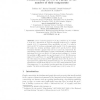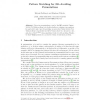ISAAC
2009
Springer
15 years 5 months ago
2009
Springer
109
click to vote
ISAAC
2009
Springer
15 years 5 months ago
2009
Springer
For a graph G and a collection of vertex pairs {(s1, t1), . . . , (sk, tk)}, the k disjoint paths problem is to find k vertex-disjoint paths P1, . . . , Pk, where Pi is a path fr...
105
click to vote
ISAAC
2009
Springer
15 years 5 months ago
2009
Springer
For a connected graph G = (V, E), a subset U ⊆ V is called a k-cut if U disconnects G, and the subgraph induced by U contains exactly k (≥ 1) components. More specifically, a ...
101
Voted
ISAAC
2009
Springer
15 years 5 months ago
2009
Springer
An induced packing of odd cycles in a graph is a packing such that there is no edge in a graph between any two odd cycles in the packing. We prove that the problem is solvable in t...
ISAAC
2009
Springer
15 years 5 months ago
2009
Springer
106
Voted
ISAAC
2009
Springer
15 years 7 months ago
2009
Springer
We study the following question, communicated to us by Mikl´os Ajtai: Can all explicit (e.g., polynomial time computable) functions f : ({0, 1}w )3 → {0, 1}w be computed by word...
137
click to vote
ISAAC
2009
Springer
15 years 7 months ago
2009
Springer
We introduce a new probing problem: what is the minimum number of cameras at fixed positions necessary and sufficient to reconstruct any strictly convex polygon contained in a dis...
106
Voted
ISAAC
2009
Springer
15 years 7 months ago
2009
Springer
It is well known that every finite abelian group G can be represented as a direct product of cyclic groups: G ∼= G1 × G2 × · · · × Gt, where each Gi is a cyclic group of ...
85
Voted
ISAAC
2009
Springer
15 years 7 months ago
2009
Springer



